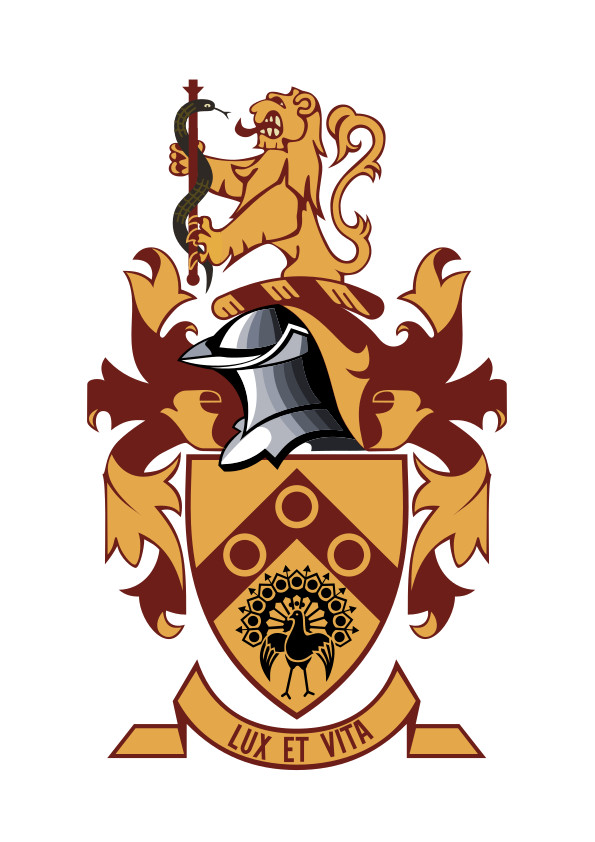Coat of Arms
The late Professor Justin van Selm, the Ophthalmologist involved with the design of our OSSA Coat of Arms, reported from Plettenberg Bay:
The Coat Of Arms Of The Ophthalmological Society Of South Africa

In the early 1970’s Dr Parma, then the Director of Heraldry, and I enjoyed lunch together in Cape Town. I explained that Ophthalmology was in need of a Coat of Arms which could be taken through to the future and which will be exclusive to our Society. After much effort, thought, research and modifications, a Coat of Arms was designed, which proved to be heraldically correct and registerable with the College of Heraldry in Pretoria, and acceptable to O.S.S.A.
To be registerable, the design has to conform to extremely strict specifications and conventions. Designing it was informative, time consuming, but fun!
A Coat of Arms differs from a badge or a logo in that it may not be worn except by the Society members itself or by one of its elected Office bearers on suitable occasions.
Coats of Arms date back to early Medieval times. It distinguished the Knights of old, not only in war but mainly in the sport of jousting. It identified the armoured wearer, not only individually, but also to which family he belonged.
Basically, a Coat of Arms consists of a shield, a helmet, a wreath, a crest, mantling and a motto.
The Shield or escutcheon, may be divided by quarterings. Its dexter (=right) side is seen from the Knight’s aspect. Decoration on the Base, that is, below the quartering, is known as the Charge. The Shield supports the Wreath which, in turn, supports the Crest. Mantling fills the background and the motto is usually below, the so-called Achievement.
In heraldic language, Azure is Blue, Gules is Red. Sable is Black, Vert is Green, Purple is Purple, Sanquine or Murrey is Blood Red, Tenné is Orange, Or is Gold.
Our Coat of Arms is therefore:
Arms: Or, on a chevron Gules’ three annulets Or, in base a peacock in his pride proper. Crest: A demi lion Or, langued and armed Gules, holding in its paws a Staff of Aesoulapius’ proper. Wreath and Mantling: Or and Gules. Motto “LUX ET VITA".
“It is hereby certified that in terms of the Heradry Act a coat of arms as illustrated and blazoned above has been registered for THE OPHTHALMOLOGICAL SOCIETY OF S.A.
N.F. Hartman: State Herald, Pretoria, Date; 7 April 1977.
The Crest was chosen because Seniors in our Profession, before qualification in Ophthalmology was possible in South Africa, received their training in Britain and The Netherlands. The snake and staff are self explanatory.
The Annulets on the Chevron represent the South African origin of our Society, taken from the Coat of Arms of Jan van Riebeeck.
The double snakes around a caduceous embellished with wings was always a Postal emblem. It never was a medical insignia, representing the winged staff of Hermes or Mercury, the messenger of the mythical Gods of ancient Greece and Rome.
The Peacock in its pride is a piece of ancient Greek mythology. It is also present on the Coat of Arms of the Moorfields Eye Hospital in London. The correlation between Eyes and a Peacock is very obvious. But what is its relation to mythology?
Zeus, the king of the Gods, assumed human form in the disguise of a boy and fell in love with Lo, the daughter of the River God. Hera, Zeus’ wife, suspected his infidelity and followed him to his trysting place in a beautiful grove. Aware of her approach, Zeus caused a dense mist to fall and changed Lo into a white heifer which Hera then commanded him to give her as a present. She instructed the god Argus, who had 100 eyes, 50% of which remained ever awake, to guard the heifer. Zeus summoned his son Hermes to release Lo. Hermes borrowed Pan’s pipes and played to Argus until he fell asleep at which stage he cut his head off. Hera, in commemoration of Argus’s death, had his eyes transferred on to the tail of a peacock.
I believe that my effort to design and establish an unique Coat of Arms for the Ophthalmological Society of South Africa is serving its purpose. I can assure you that it confirms to all the requirements of heraldry. On a personal basis I am proud of this contribution.
OCTOBER 2008.